What is a Lichen ??
The algal partners are far less numerous than fungal partners. In other words any given species of algae will probably form part of several if not many different lichens. Many, if not all the algal partners can exist on their own in some habitats, however, normally when part of a lichen they have a much greater distribution.
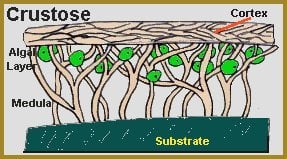 Crustose
lichens, as their name implies, form a crust on the surface of the
substrate on which they are growing. This crust can be quite thick and
granular or actually embedded within the substrate. In this latter case
the fruiting bodies still rise above the surface. In many crustose
lichens the surface of the thallus breaks up into a cellular,
crazy-paving like pattern. Crustose lichens tend to grow out from their
edges and have their fruiting bodies in their centre. Crustose lichens
are very difficult to remove from their substrates.
Crustose
lichens, as their name implies, form a crust on the surface of the
substrate on which they are growing. This crust can be quite thick and
granular or actually embedded within the substrate. In this latter case
the fruiting bodies still rise above the surface. In many crustose
lichens the surface of the thallus breaks up into a cellular,
crazy-paving like pattern. Crustose lichens tend to grow out from their
edges and have their fruiting bodies in their centre. Crustose lichens
are very difficult to remove from their substrates.
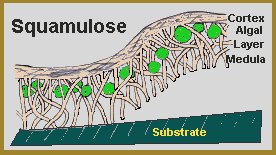
Some lichens have a portion of their thallus lifted off the substrate to form 'squamules'. They are otherwise similar to crustose lichens in that they possess an upper cortex but no lower cortex.
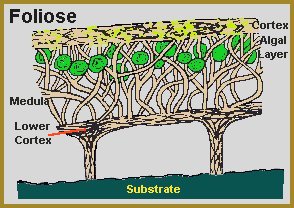
These have an upper and lower cortex. They are generally raised to some extent above the substrate but connected to it by rhizines (specialised root-like hyphae). They are easier to remove from their substrate when collecting because of this.
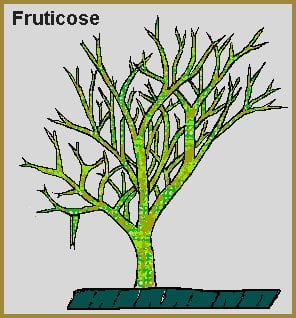
Fruticose lichens are shrubby lichens. They are attached to their substrate by a single point and rise, or more usually, dangle from this. Some foliose lichens can be stubby like fruticose lichens, however, close examination will reveal that the algal part exists only on one side of the flattish thallus whereas in fruticose lichens it exists as a ring around the thallus, even when it is flattened as in Ramalina sp.
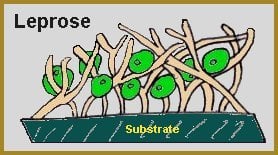
Leprose lichens are an odd group of lichens which have never been observed to produce fruiting bodies. Because knowledge of the form of the fruiting bodies is essential to the identification of fungi, these lichens have not yet been identified properly, or at least not yet given full scientific names. These fungi not only lack an inner cortex, but also lack an outer one, i.e. no cortex, only an algal cell layer and sometimes a weakly defined medulla.
A lichen is a symbiosis. That means that it is two or more organisms
living together such that both are more successful within the
partnership than they would have been if they were living on their own.
With lichens the basic components of this partnership are 1) a fungus
called the 'mycobiont' and 2) one or more algae and/or a cyanobacteria
called the 'photobiont'.
The true nature of the symbiosis between
this two partners is still being debated by scientists and some would maintain
that the fungus is a parasite on the photobiont. However, in many cases, the
algae in question cannot survive alone in the habitat occupied by the lichen
any more than the unattached fungi can, so it is not realistic to use the term
parasite.
The fungal partners are mostly (over 95%)
Ascomycetes. Most of the rest are Basidiomycetes. As far as science has been
able to discover few if any of the fungi involved can survive and reproduce in
the wild on their own. Each lichen species contains a different species of
fungi and so it is according to the species of fungi that lichens are
classified. This classification is generally based on characteristics of the
thallus and reproductive organs. There are between 13500 and 17000 species of
lichen depending on whose classification you believe. About 20% of fungal
species are involved in lichen partnerships.
The algal partners are far less numerous than fungal partners. In other words any given species of algae will probably form part of several if not many different lichens. Many, if not all the algal partners can exist on their own in some habitats, however, normally when part of a lichen they have a much greater distribution.
Who Benefits
he fungal partner benefits by getting sugars, its only nutriment from
the algae which being green synthesises sugars through photosynthesis.
The algal partner gets protection as the fungi normally forms the outer
surface. This protection is against the weather mostly, it results in
the algae having a more stable and constant environment to live in
allowing it to grow better. The fungi collects the sugars by means of
special hyphae called appressoria or haustoria which contact the wall of
the algal cells. The fungi may produce a substance which increases the
permeability of the algal cell walls such that they cells lose as much
as 80% of the sugars that they produce. The sugars pass into the algal
hyphae through diffusion.
Morphology
Morphologically, lichens are made up of a few distinct characters.
The most obvious is the thallus. The form of the thallus is a result of
the fungal species involved. The thallus is the body of the lichen.
Most of what you see, if it isn't reproductive structures, is thallus.
The fungal hyphae (filaments) branch and then fuse together (anastomose)
when they meet to form a mesh of hair-like threads. The top surface is
normally a layer of tightly packed hyphae called a 'cortex'. Below
this is the algal layer where the photobiont lives. Below this is the
medulla an area of loose hyphae in which nutrients are stored.
Sometimes a lower cortex exists, in others the medulla rests on the
surface. In crustose and squamulose lichens there is no lower cortex.
In foliose lichens there is a lower cortex and in fruticose lichens the
lower cortex is replaced by a central one.
Filamentous lichens are totally different. They consist of chains
of algal cells wrapped around with fungal hyphae. Because nature was
not designed to fit into our classification schemes some things
inevitably to do not fit. In lichens it is the genus Cladonia.
Cladonia are a successful group of lichens which have a primary thallus
and a secondary thallus. The primary thallus is small and clings
closely to the substrate while the secondary thallus is a shrubby growth
like fruticose lichens. Once the lichen is established the primary
thallus often dies off.
Crustose Lichens
 Crustose
lichens, as their name implies, form a crust on the surface of the
substrate on which they are growing. This crust can be quite thick and
granular or actually embedded within the substrate. In this latter case
the fruiting bodies still rise above the surface. In many crustose
lichens the surface of the thallus breaks up into a cellular,
crazy-paving like pattern. Crustose lichens tend to grow out from their
edges and have their fruiting bodies in their centre. Crustose lichens
are very difficult to remove from their substrates.
Crustose
lichens, as their name implies, form a crust on the surface of the
substrate on which they are growing. This crust can be quite thick and
granular or actually embedded within the substrate. In this latter case
the fruiting bodies still rise above the surface. In many crustose
lichens the surface of the thallus breaks up into a cellular,
crazy-paving like pattern. Crustose lichens tend to grow out from their
edges and have their fruiting bodies in their centre. Crustose lichens
are very difficult to remove from their substrates.
Squamulose lichens

Some lichens have a portion of their thallus lifted off the substrate to form 'squamules'. They are otherwise similar to crustose lichens in that they possess an upper cortex but no lower cortex.
Foliose Lichens

These have an upper and lower cortex. They are generally raised to some extent above the substrate but connected to it by rhizines (specialised root-like hyphae). They are easier to remove from their substrate when collecting because of this.
Fruticose Lichens

Fruticose lichens are shrubby lichens. They are attached to their substrate by a single point and rise, or more usually, dangle from this. Some foliose lichens can be stubby like fruticose lichens, however, close examination will reveal that the algal part exists only on one side of the flattish thallus whereas in fruticose lichens it exists as a ring around the thallus, even when it is flattened as in Ramalina sp.
Leprose Lichens

Leprose lichens are an odd group of lichens which have never been observed to produce fruiting bodies. Because knowledge of the form of the fruiting bodies is essential to the identification of fungi, these lichens have not yet been identified properly, or at least not yet given full scientific names. These fungi not only lack an inner cortex, but also lack an outer one, i.e. no cortex, only an algal cell layer and sometimes a weakly defined medulla.

Tidak ada komentar:
Posting Komentar